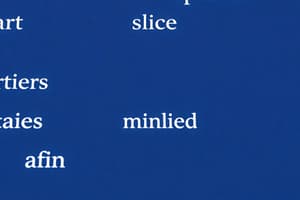Podcast
Questions and Answers
Proper sentence structure relies heavily on the use of punctuation marks such as commas and periods.
Proper sentence structure relies heavily on the use of punctuation marks such as commas and periods.
True (A)
Subject-verb agreement is not considered an important grammatical rule.
Subject-verb agreement is not considered an important grammatical rule.
False (B)
Phrases and clauses can include the use of modals like can, should, and would.
Phrases and clauses can include the use of modals like can, should, and would.
True (A)
Run-on sentences are a well-structured form of writing.
Run-on sentences are a well-structured form of writing.
Conditional sentences can only be in the first conditional form.
Conditional sentences can only be in the first conditional form.
The main purpose of grammar is to enhance writing and speaking clarity.
The main purpose of grammar is to enhance writing and speaking clarity.
A compound sentence contains only one independent clause.
A compound sentence contains only one independent clause.
In grammar, adjectives often describe verbs.
In grammar, adjectives often describe verbs.
The structure of a simple sentence is typically Subject-Verb-Object.
The structure of a simple sentence is typically Subject-Verb-Object.
The past tense describes actions that are currently happening.
The past tense describes actions that are currently happening.
Active voice indicates that the subject receives the action in the sentence.
Active voice indicates that the subject receives the action in the sentence.
Interjections are used to connect words or clauses in a sentence.
Interjections are used to connect words or clauses in a sentence.
Perfect tense is used to express actions that will occur in the future.
Perfect tense is used to express actions that will occur in the future.
Flashcards
Parts of Speech
Parts of Speech
Different word types in English with specific functions.
Nouns
Nouns
Words naming people, places, things, or ideas.
Pronouns
Pronouns
Words that replace nouns to avoid repetition.
Verbs
Verbs
Signup and view all the flashcards
Adjectives
Adjectives
Signup and view all the flashcards
Adverbs
Adverbs
Signup and view all the flashcards
Prepositions
Prepositions
Signup and view all the flashcards
Conjunctions
Conjunctions
Signup and view all the flashcards
Interjections
Interjections
Signup and view all the flashcards
Sentence Structure
Sentence Structure
Signup and view all the flashcards
SVO
SVO
Signup and view all the flashcards
Simple Sentences
Simple Sentences
Signup and view all the flashcards
Compound Sentences
Compound Sentences
Signup and view all the flashcards
Complex Sentences
Complex Sentences
Signup and view all the flashcards
Compound-Complex Sentences
Compound-Complex Sentences
Signup and view all the flashcards
Tenses
Tenses
Signup and view all the flashcards
Active Voice
Active Voice
Signup and view all the flashcards
Passive Voice
Passive Voice
Signup and view all the flashcards
English Grammar
English Grammar
Signup and view all the flashcards
Verb Conjugation
Verb Conjugation
Signup and view all the flashcards
Pronoun Agreement
Pronoun Agreement
Signup and view all the flashcards
Punctuation Marks
Punctuation Marks
Signup and view all the flashcards
Subject-Verb Agreement
Subject-Verb Agreement
Signup and view all the flashcards
Sentence Structure
Sentence Structure
Signup and view all the flashcards
Comma Usage
Comma Usage
Signup and view all the flashcards
Run-on Sentence
Run-on Sentence
Signup and view all the flashcards
Tense
Tense
Signup and view all the flashcards
Misplaced Modifiers
Misplaced Modifiers
Signup and view all the flashcards
Clauses
Clauses
Signup and view all the flashcards
Phrases
Phrases
Signup and view all the flashcards
Modals
Modals
Signup and view all the flashcards
Conditional Sentences
Conditional Sentences
Signup and view all the flashcards
Active Voice
Active Voice
Signup and view all the flashcards
Passive Voice
Passive Voice
Signup and view all the flashcards
Idioms
Idioms
Signup and view all the flashcards
Phrasal Verbs
Phrasal Verbs
Signup and view all the flashcards
Study Notes
English Grammar Overview
- English grammar describes the rules governing the structure of the English language.
- It includes the rules for forming words (morphology), phrases, clauses, and sentences (syntax).
- Understanding grammar helps in effectively communicating and interpreting thoughts and ideas through written and spoken English.
- Different levels of grammar study exist, from basic components to advanced grammatical concepts (like parts of speech, sentence structures, tenses, and voice).
Parts of Speech
- Nouns: Names of persons, places, things, or ideas (e.g., dog, city, happiness).
- Pronouns: Words that replace nouns (e.g., he, she, it, they).
- Verbs: Actions or states of being (e.g., run, is, feel).
- Adjectives: Words that describe nouns (e.g., big, red, happy).
- Adverbs: Words that describe verbs, adjectives, or other adverbs (e.g., quickly, very, loudly).
- Prepositions: Show relationships between words (e.g., on, in, at).
- Conjunctions: Connect words, phrases, or clauses (e.g., and, but, or).
- Interjections: Express strong feelings (e.g., ouch!, wow!).
Sentence Structure
- Subject-Verb-Object (SVO): A common sentence structure (e.g., The dog chased the cat).
- Subject-Verb (SV): Can express complete meanings (e.g., It rains).
- Simple Sentences: Contain one independent clause (e.g., The cat slept).
- Compound Sentences: Contain two independent clauses joined by a conjunction (e.g., The cat slept, and the dog barked).
- Complex Sentences: Contain one independent clause and one or more dependent clauses (e.g., Because the cat slept, the dog ate).
- Compound-Complex Sentences: Contain two or more independent clauses and one or more dependent clauses (e.g., The cat slept and the dog barked, because it was tired).
Tenses
- Present Tense: Describes actions happening now, habits, general truths.
- Past Tense: Describes actions that happened in the past.
- Future Tense: Describes actions that will happen in the future.
- Perfect Tense: Indicates actions completed at a point in time.
- Progressive Tense: Shows actions in progress.
Voice
- Active Voice: Subject performs the action (e.g., The dog chased the cat).
- Passive Voice: Subject receives the action (e.g., The cat was chased by the dog).
Grammar Rules
- Grammar rules dictate how words should be arranged and used to form grammatically correct sentences.
- These vary depending on the context and the intended meaning.
- Rules concerning verb conjugations, pronoun agreement, and modifying words are crucial to forming clear and correct sentences.
Punctuation
- Punctuation marks are used to organize and clarify written expressions.
- They include: periods, commas, semicolons, colons, question marks, exclamation points, apostrophes, quotation marks, parentheses, brackets.
- Using correct punctuation is crucial to proper sentence structure and clarity.
Common Grammatical Errors
- Subject-verb agreement issues.
- Misuse of tenses.
- Incorrect pronoun use and agreement.
- Problems with misplaced modifiers.
- Poor comma usage.
- Run-on sentences and sentence fragments can also be common problems.
Advanced Grammar Topics
- Clauses (dependent and independent).
- Phrases (prepositional, participial).
- Modals (can, should, would).
- Conditional sentences (first, second, third conditional structures).
- Voice (active, passive, and their use).
- Idioms and phrasal verbs.
Studying That Suits You
Use AI to generate personalized quizzes and flashcards to suit your learning preferences.




